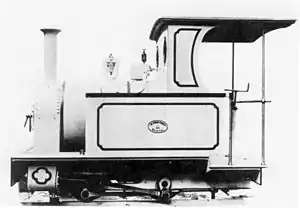| Rand Mines NG 0-4-0T South African NG 99999-4-0T | |||||||||||||||||||||||||||||||||||||||||||||||||||||||
|---|---|---|---|---|---|---|---|---|---|---|---|---|---|---|---|---|---|---|---|---|---|---|---|---|---|---|---|---|---|---|---|---|---|---|---|---|---|---|---|---|---|---|---|---|---|---|---|---|---|---|---|---|---|---|---|
 South African NG 0-4-0T of 1899, ex Rand Mines | |||||||||||||||||||||||||||||||||||||||||||||||||||||||
| |||||||||||||||||||||||||||||||||||||||||||||||||||||||
| |||||||||||||||||||||||||||||||||||||||||||||||||||||||
| |||||||||||||||||||||||||||||||||||||||||||||||||||||||
| |||||||||||||||||||||||||||||||||||||||||||||||||||||||
The South African Railways NG 0-4-0T of 1899 was a narrow-gauge steam locomotive from the pre-Union era in Transvaal and Natal.
In 1899, Rand Mines acquired two narrow-gauge 0-4-0T steam locomotives from Avonside Engine Company and, in 1900, a similar locomotive was delivered to Reynolds Brothers Sugar Estates of Esperanza in Natal. In 1915, when an urgent need arose for additional narrow-gauge locomotives in German South West Africa during the First World War, these three locomotives were purchased second-hand by the South African Railways.[1][2]
Manufacturer
In 1899, Avonside Engine Company delivered two 24-inch gauge (610-millimetre) locomotives to Rand Mines on the Witwatersrand. In 1900, a third similar locomotive, but of 20 inches (508 millimetres) gauge, was delivered to Reynolds Brothers Sugar Estates in Natal. The latter was one of several of the same type which saw service on the Reynolds, Huletts and Chakaskraal sugar plantations in Natal.[1]
First World War
In 1915, while the military campaign was in progress against German forces in Deutsch-Südwest-Afrika (DSWA) during the First World War, an urgent need arose for additional locomotives for use on the narrow-gauge lines in that territory. The South African Railways (SAR) therefore purchased these three 0-4-0T locomotives second-hand on behalf of the Defence Department. The two engines from Rand Mines were numbered NG91 and NG92, while the engine from Reynolds Brothers was numbered NG95. Since a narrow-gauge locomotive classification system had not yet been implemented on the SAR, they were not classified.[1][2]
Service
Whether all three were placed in service by the SAR is not certain, since engine no. NG95 from Reynolds Brothers would not be usable without first being regauged to 24 inches (610 millimetres) gauge. It is also unclear whether any of them were actually placed in service in DSWA or whether they were used to replace other SAR narrow-gauge locomotives which had been commandeered by the Union Defence Forces for war service in DSWA.[1]
The locomotives were withdrawn from SAR service and sold towards the end of the war in 1918.[1][3]
References
- 1 2 3 4 5 Paxton, Leith; Bourne, David (1985). Locomotives of the South African Railways (1st ed.). Cape Town: Struik. p. 114. ISBN 0869772112.
- 1 2 Espitalier, T.J.; Day, W.A.J. (1945). The Locomotive in South Africa – A Brief History of Railway Development. Chapter VII – South African Railways (Continued). South African Railways and Harbours Magazine, October 1945. p. 781.
- ↑ Dulez, Jean A. (2012). Railways of Southern Africa 150 Years (Commemorating One Hundred and Fifty Years of Railways on the Sub-Continent – Complete Motive Power Classifications and Famous Trains – 1860–2011) (1st ed.). Garden View, Johannesburg, South Africa: Vidrail Productions. pp. 232–233. ISBN 9 780620 512282.